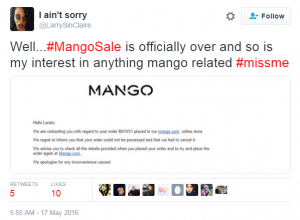There are many different factors that influence a customers purchasing decision to buy from you and not your competitor. They can be linked to your advertising or marketing campaigns or the credibility of your products and services; amongst other things. Word of mouth carries a lot more weight than other forms of marketing, which is why online influencers and ambassadors are on the rise thanks to social media. A brand’s reputation is at the centre of business success, and a high price isn’t a deterrent to many consumers, as long as the brand enjoys a good reputation.
With that said, consumers love a good bargain, which was seemingly the case when international fashion retailer Mango posted a #MangoSale on May 16th, sighting as much as 300% off certain items, with some going for as little as R1. Anyone would assume this must have been a glitch on the website, however the sale was still up after a few hours, giving consumers enough time to save hundreds of rands on designer items that would have cost a pretty penny at their original price.
Once the error had been identified, Mango’s team then opted to email consumers who had taken part in the sale, alerting them to the fact that their orders would be cancelled and their monies refunded. No press release. No apology. Just a simple email, which had many customers citing the consumer protection act and threatening to amplify their frustrations on social media and through reputable news sites. “During a crisis, user-generated content and the subsequent online reputation of a brand is put under the spotlight” – Vincent Magwenya. Furthermore, Mango quickly amended the terms and conditions on their website, which didn’t go unnoticed.
This is where good crisis communication is key to maintaining a positive reputation.
Consumers know the rules of engagement and want you to engage & keep them informed.. If you don’t, they will call you on it. Every brand has to handle issues or crises, it is how you handle them that the consumers will remember, and that is what will ultimately affect your bottom line.
A thoughtful reply, even without having to admit fault, shows that one cares about their customers, wants to retain their loyalty and is serious about mending the trust that has been broken. Having a crisis management plan and team in place is crucial to avoiding unnecessary backlash and damage to the brand, as well as managing customers and stakeholders’ relations. We all know that failure to plan is planning to fail; therefore how you rise up from your errors ensures that you enjoy a positive reputation that lives well beyond the crisis.
Tiisetso Gama, Internal Communications Manager


